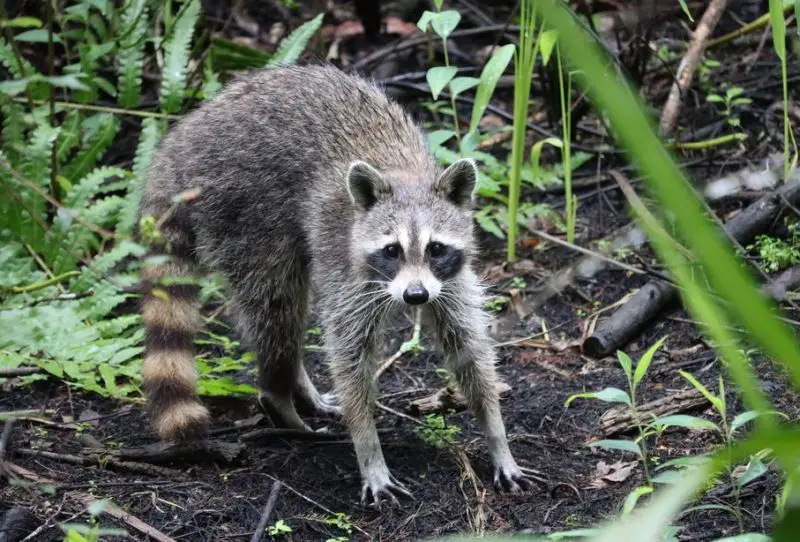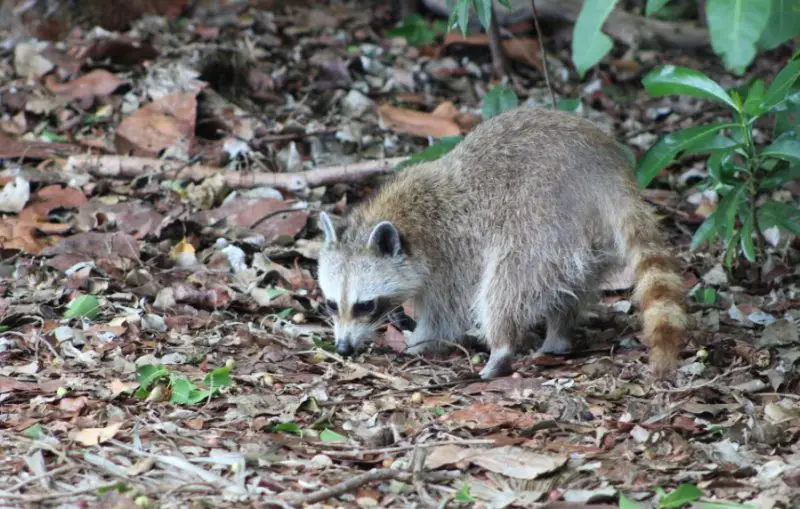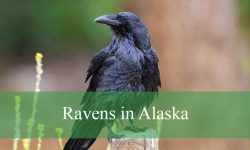Florida’s wildlife is incredibly diverse, and among its most recognizable mammals is the raccoon. Known for its clever behavior, curious nature, and unmistakable facial mask, the raccoon thrives in many different environments across the state. Although most people think of raccoons as a single species, Florida is home to three distinct types, including regional subspecies that have adapted to unique habitats. These include the widespread Common Raccoon, the Florida Raccoon, and the rare Keys Raccoon, each with characteristics that make them fascinating to study and observe.
This article provides an in-depth look at the three types of raccoons in Florida, covering their physical traits, behavior, size, feeding habits, reproductive patterns, and habitats. With pictures and identification tips, you will be able to recognize each type more easily and understand the crucial role raccoons play in the ecosystems of the Sunshine State.
The Common Raccoon (Procyon lotor lotor)

Characteristics and Identification
The Common Raccoon is the most familiar type found across Florida and much of North America. Its fur is generally grayish-brown with a dense undercoat, giving it a slightly shaggy appearance. The most recognizable features include the black facial mask that stretches across the eyes and the bushy tail marked with alternating dark and light rings. Adults typically weigh between 15 to 20 pounds, though size varies with available food sources. Males are usually larger than females, and both possess dexterous front paws capable of manipulating food and objects with surprising skill.
In Florida, this raccoon often appears more slender compared to its northern relatives, primarily due to the warmer climate. The coat is not as thick as those in colder regions, but the key identifiers—the mask and tail rings—remain the same. These visual traits make the Common Raccoon easy to distinguish even at night, when their reflective eyes shine brightly under headlights or flashlights.
Behavior and Activity
The Common Raccoon is primarily nocturnal, although it may sometimes be seen during the day in suburban areas. It is a solitary forager, but mothers are often seen with their young during the spring and summer months. Highly adaptable, this raccoon is comfortable in a wide range of habitats, from swamps and forests to neighborhoods and city streets. It is also an excellent climber and swimmer, traits that give it access to food in diverse environments.
In Florida, the raccoon often uses hollow trees, abandoned burrows, or attics as dens. These resting places provide safety during the day and a sheltered spot for raising offspring. Unlike northern raccoons, Florida populations do not undergo long periods of winter dormancy since the state’s mild climate supports year-round activity.
Feeding Habits
Diet is one of the key factors that explains the success of the Common Raccoon in Florida. This species is omnivorous and opportunistic, feeding on whatever is available in its habitat. Wild diets often include frogs, crayfish, fish, insects, fruits, nuts, and small mammals. Along coastal areas, raccoons can be found probing oyster beds or flipping over rocks in search of crabs.
In suburban areas, they frequently raid garbage cans, bird feeders, and pet food bowls, which sometimes leads to conflicts with humans. Their nimble paws make them skilled at opening containers and even doors. The variety in their diet ensures they can thrive in virtually any environment the state provides.
Reproduction and Life Cycle
The mating season of the Common Raccoon in Florida generally occurs from January to March. After a gestation period of about 63 days, females give birth to litters of two to five kits. The young are born blind and helpless, depending on the mother for food and protection. By eight weeks, the kits begin exploring outside the den and learning foraging skills from their mother.
By late summer, juveniles become more independent, though they may remain with the mother until fall. In the wild, raccoons typically live around two to three years due to predation and disease, but some individuals may survive up to five years.
Habitat and Distribution in Florida
The Common Raccoon inhabits every region of Florida, from the Panhandle to the southern tip. It thrives in forests, marshes, cypress swamps, mangroves, and even urban neighborhoods. Since it requires access to water, raccoons are often spotted near rivers, lakes, and coastal wetlands. Their wide distribution highlights their adaptability and resilience in different ecosystems.
The Florida Raccoon (Procyon lotor elucus)

Characteristics and Identification
The Florida Raccoon is recognized as a subspecies adapted to the state’s warmer climate. Compared to the northern raccoon, it tends to be slightly smaller and leaner, with a lighter coat that appears more brownish-gray. Despite these subtle differences, it retains the defining black mask and ringed tail. Weighing between 10 to 18 pounds on average, it is a medium-sized mammal that blends easily into both wild and suburban landscapes.
One distinguishing feature of the Florida Raccoon is its more slender build, which helps it navigate swampy environments and coastal mangroves. Its fur is less dense, making it more suitable for humid conditions. These physical traits are essential for surviving in habitats where temperatures remain high throughout the year.
Behavior and Activity
Like its relatives, the Florida Raccoon is nocturnal and opportunistic. It emerges at dusk to forage and is especially skilled at adapting to environments influenced by human presence. It is often observed exploring campsites, rummaging through trash bins, and feeding in residential areas. Its intelligence and problem-solving abilities have made it one of Florida’s most successful urban wildlife species.
In natural habitats, the Florida Raccoon relies on tree hollows, palmetto thickets, and coastal mangrove roots for shelter. It is also an agile swimmer, moving easily between wetland areas. Social behavior is typically limited to mothers with young or occasional loose groupings where food is abundant.
Feeding Habits
The Florida Raccoon’s diet mirrors that of the common type but is especially rich in aquatic food sources. In swampy and coastal areas, it feeds on clams, crabs, mussels, and small fish. Fruits, berries, frogs, insects, and eggs of ground-nesting birds are also part of its menu. Its ability to exploit both natural and human-provided food sources gives it a strong survival advantage.
In rural areas, it may pose a threat to poultry farms by raiding chicken coops, while in suburban settings it is notorious for tipping over garbage cans. Despite these conflicts, the raccoon plays a valuable ecological role by controlling insect and rodent populations.
Reproduction and Life Cycle
Breeding in the Florida Raccoon generally occurs early in the year, with most litters born between March and May. The female raises her young alone, choosing safe dens that keep predators away. The young grow quickly in the warm climate and often begin foraging with their mother within a couple of months.
By late summer, the juveniles disperse to establish their own territories. Average lifespan in the wild remains two to three years, though raccoons in areas with fewer predators and abundant food sometimes live longer.
Habitat and Distribution in Florida
The Florida Raccoon is widespread throughout the peninsula, thriving in pine flatwoods, hardwood hammocks, mangroves, and marshes. It is particularly abundant in central and southern Florida, where warm temperatures and abundant wetlands provide ideal conditions. This subspecies exemplifies adaptability, moving fluidly between wild habitats and human-altered landscapes.
The Keys Raccoon (Procyon lotor auspicatus)

Characteristics and Identification
The Keys Raccoon is a rare and unique subspecies restricted to the islands of the Florida Keys. It is the smallest raccoon type in the state, typically weighing between 8 to 12 pounds, with a shorter body length than mainland counterparts. Its fur is lighter in color, often appearing silvery-gray, which helps it blend into the sandy and rocky island environments.
Its compact size is thought to be an adaptation to limited food availability on the islands, a phenomenon known as insular dwarfism. Like all raccoons, it has the signature black mask and ringed tail, though these markings are sometimes less bold compared to the Common Raccoon.
Behavior and Activity
The Keys Raccoon is nocturnal, emerging at night to forage across beaches, mangrove edges, and coastal thickets. It is more vulnerable than mainland raccoons due to its restricted range and smaller population size. Although solitary by nature, it may be observed in small family groups during the breeding season.
These raccoons are cautious and less likely to be seen in populated areas compared to the Florida Raccoon. Their shy nature is partly due to their limited habitat, where they face threats from development, road mortality, and habitat loss.
Feeding Habits
Diet in the Keys Raccoon is heavily influenced by coastal resources. They feed on crabs, shellfish, snails, and small fish found in tidal zones. In addition, they consume fruits, berries, and seeds from native island vegetation. Because food sources are limited, they often travel greater distances across the islands compared to mainland raccoons in search of meals.
Unlike raccoons in urban areas, the Keys Raccoon rarely relies on human food sources, since much of its range is in natural or protected areas. Its diet plays a critical role in maintaining the ecological balance of the Keys’ fragile environment.
Reproduction and Life Cycle
The breeding cycle of the Keys Raccoon follows a similar pattern to other raccoons, with mating occurring in late winter to early spring. Litters are usually small, with two to four kits born in protected dens. The young remain with the mother throughout the summer before becoming independent.
Due to their small population size and isolated range, survival rates are lower than in other subspecies. Conservation measures are essential to ensure the continued survival of this unique Florida mammal.
Habitat and Distribution in Florida
The Keys Raccoon is restricted entirely to the Florida Keys, making it one of the state’s most geographically limited mammals. Its habitat includes mangrove forests, sandy beaches, and island hammocks. Because development in the Keys continues to expand, habitat fragmentation poses a serious threat. Road mortality and competition with feral animals further endanger this subspecies.
Conservation groups monitor populations closely, and protected areas within the Keys serve as important refuges. Without careful management, the Keys Raccoon could face significant declines in the coming decades.
Conclusion
Raccoons are some of the most adaptable and resourceful mammals in Florida. From the widespread Common Raccoon to the specialized Florida Raccoon and the rare Keys Raccoon, each type reflects a different ecological story. They share the familiar mask and ringed tail but differ in size, habitat preferences, and behaviors that make them unique.
By understanding their characteristics, feeding habits, reproductive patterns, and habitats, we can better appreciate the role raccoons play in Florida’s ecosystems. Protecting subspecies like the Keys Raccoon is especially important, as their survival depends on conservation efforts. Whether encountered in a swamp, a mangrove forest, or even a backyard, raccoons remain an integral part of Florida’s wildlife heritage.
FAQs about Raccoons in Florida
What types of raccoons live in Florida?
Florida is home to three types of raccoons: the Common Raccoon, the Florida Raccoon, and the Keys Raccoon. The Common Raccoon is widespread across the state, while the Florida Raccoon is a subspecies adapted to warm climates, and the Keys Raccoon is a rare island subspecies found only in the Florida Keys.
How can you identify raccoons in Florida?
Raccoons are easily recognized by their gray to brown fur, bushy ringed tail, and distinctive black “mask” across the eyes. The Florida Raccoon is slightly smaller and leaner than northern types, while the Keys Raccoon is the smallest of all, with lighter-colored fur and a more compact body.
What do raccoons eat in Florida?
Raccoons in Florida are omnivores, eating a wide variety of foods such as crabs, clams, frogs, fish, insects, fruits, berries, and eggs. In suburban areas, they often raid trash cans, bird feeders, and pet food bowls, which makes them common around human settlements.
Are raccoons in Florida dangerous?
Raccoons are not aggressive unless cornered or threatened. However, they can carry diseases such as rabies and parasites like roundworms. It is important to avoid direct contact, never feed wild raccoons, and secure garbage bins to prevent unwanted encounters.
Do raccoons in Florida hibernate?
Unlike northern raccoons, Florida raccoons do not hibernate because of the state’s warm climate. They remain active year-round, although they may be less active during very hot or rainy periods.
Where can you see raccoons in Florida?
Raccoons are found throughout Florida in forests, swamps, marshes, mangroves, and even urban areas. The Keys Raccoon is restricted to the islands of the Florida Keys, while the Common and Florida Raccoon can be seen in nearly every part of the state.
Are Keys Raccoons endangered?
Yes, the Keys Raccoon is considered threatened due to its small population and restricted range in the Florida Keys. Habitat loss, road mortality, and human activity continue to put pressure on this rare subspecies.






